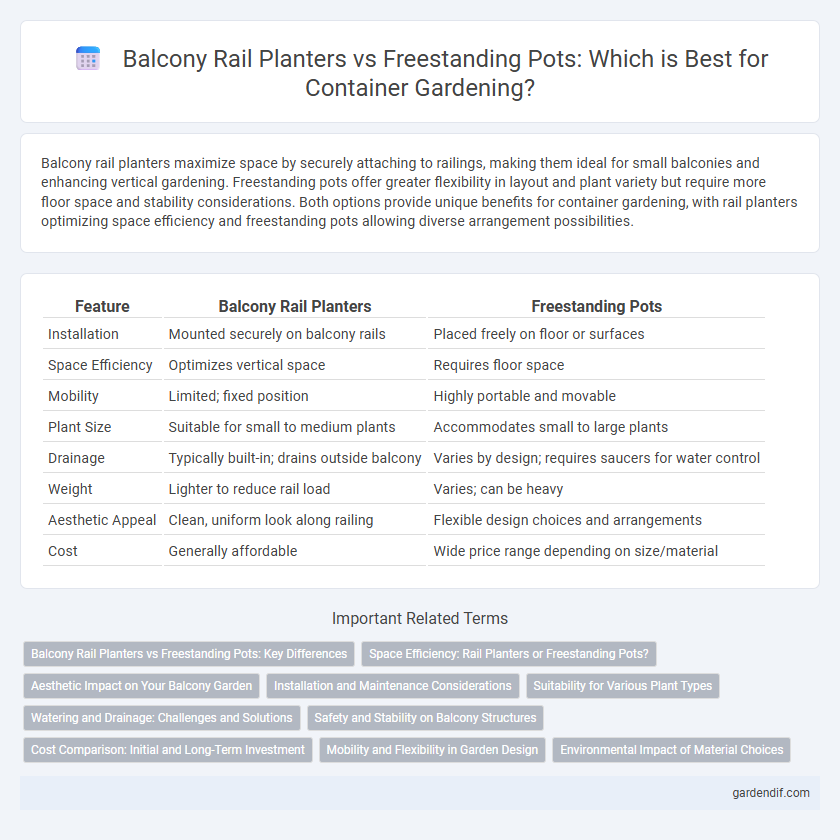
Balcony rail planters vs freestanding pots Illustration
Balcony rail planters maximize space by securely attaching to railings, making them ideal for small balconies and enhancing vertical gardening. Freestanding pots offer greater flexibility in layout and plant variety but require more floor space and stability considerations. Both options provide unique benefits for container gardening, with rail planters optimizing space efficiency and freestanding pots allowing diverse arrangement possibilities.
Table of Comparison
| Feature | Balcony Rail Planters | Freestanding Pots |
|---|---|---|
| Installation | Mounted securely on balcony rails | Placed freely on floor or surfaces |
| Space Efficiency | Optimizes vertical space | Requires floor space |
| Mobility | Limited; fixed position | Highly portable and movable |
| Plant Size | Suitable for small to medium plants | Accommodates small to large plants |
| Drainage | Typically built-in; drains outside balcony | Varies by design; requires saucers for water control |
| Weight | Lighter to reduce rail load | Varies; can be heavy |
| Aesthetic Appeal | Clean, uniform look along railing | Flexible design choices and arrangements |
| Cost | Generally affordable | Wide price range depending on size/material |
Balcony Rail Planters vs Freestanding Pots: Key Differences
Balcony rail planters attach securely to railings, maximizing limited balcony space and enhancing safety by preventing pots from tipping. Freestanding pots offer greater flexibility in placement and size variety but require flat, stable surfaces and occupy more floor area. Choosing between them depends on available space, desired aesthetics, and maintenance preferences for container gardening on balconies.
Space Efficiency: Rail Planters or Freestanding Pots?
Balcony rail planters maximize space by attaching directly to railings, freeing up floor area for movement or additional containers, while freestanding pots consume valuable floor space but allow greater flexibility in arrangement and plant size. Rail planters are ideal for small balconies where space efficiency is critical, enabling vertical gardening without cluttering walking paths. Freestanding pots suit larger balconies or patios where space permits diverse plant groupings and easier relocation for sunlight optimization.
Aesthetic Impact on Your Balcony Garden
Balcony rail planters create a cohesive and streamlined look by utilizing vertical space efficiently, enhancing the visual flow without cluttering the floor area. Freestanding pots offer versatility in arrangement, allowing for dynamic design changes and focal points that can highlight specific plants or garden themes. Combining both can elevate the balcony garden's aesthetic by balancing structured greenery with flexible, personalized plant displays.
Installation and Maintenance Considerations
Balcony rail planters offer easy installation by securely attaching to existing balcony railings, saving floor space and providing stability in windy conditions. Freestanding pots require stable, flat surfaces and may need additional supports or saucers to prevent tipping and water damage to floors. Maintenance for rail planters often involves regularly checking brackets and drainage to prevent rust or clogging, while freestanding pots allow for easier mobility and cleaning around the planter base.
Suitability for Various Plant Types
Balcony rail planters are ideal for trailing plants, herbs, and compact flowers due to their narrow design and easy access to sunlight. Freestanding pots offer greater versatility, accommodating larger root systems and a broader variety of plants, including shrubs and small trees. Choosing between the two depends on plant size, root depth, and exposure needs.
Watering and Drainage: Challenges and Solutions
Balcony rail planters often face watering and drainage challenges due to limited soil volume and restricted water flow, which can lead to root rot or dehydration if not managed properly. Solutions include choosing planters with built-in drainage holes, using self-watering designs, and applying water-retentive soil mixes to maintain consistent moisture levels. Freestanding pots provide more flexibility for drainage management with larger soil capacity and multiple drainage options, but they still require careful watering schedules to prevent waterlogging or drying out.
Safety and Stability on Balcony Structures
Balcony rail planters are designed to securely attach to railings, providing enhanced stability and reducing the risk of accidental falls, especially in high-rise buildings. Freestanding pots, while versatile, can pose safety risks if placed near edges without proper anchoring, potentially causing tipping hazards during strong winds or accidental bumps. Ensuring balcony structures are capable of supporting the weight and implementing secure mounting systems for rail planters improves overall safety and prevents structural strain.
Cost Comparison: Initial and Long-Term Investment
Balcony rail planters generally have a lower initial cost due to their compact design and minimal materials compared to larger freestanding pots. Over time, freestanding pots may require more frequent replacement or repair due to exposure and size, increasing long-term investment costs. Budget-conscious gardeners often prefer balcony rail planters for their cost-effectiveness and ease of maintenance in limited spaces.
Mobility and Flexibility in Garden Design
Balcony rail planters offer limited mobility as they are fixed to railing structures, restricting repositioning options within garden spaces. Freestanding pots provide superior flexibility, enabling gardeners to easily move plants to optimize sunlight exposure, accommodate seasonal changes, or redesign layouts. This mobility enhances dynamic garden designs and allows for effortless adaptation to evolving aesthetic or environmental needs.
Environmental Impact of Material Choices
Balcony rail planters typically use lightweight, recycled plastics that reduce carbon footprints compared to traditional ceramics in freestanding pots, which often require more energy-intensive manufacturing processes. Materials like bamboo or reclaimed wood for rail planters offer biodegradable options, minimizing landfill waste unlike many non-recyclable freestanding pot materials. Choosing sustainable, durable containers helps lower environmental impact by reducing resource consumption and promoting longer product lifespans.
Balcony rail planters vs freestanding pots Infographic

 gardendif.com
gardendif.com